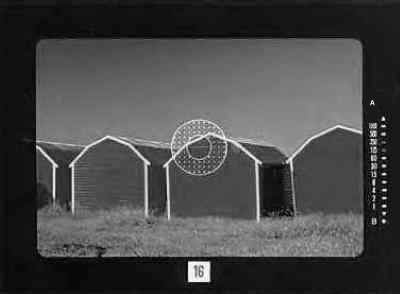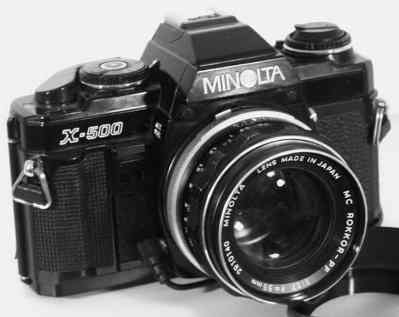

X-570
(1983) Minolta realized that the X-700 was designed for the top-tier of the photographic market. Sure, it had cutting-edge features, but it was just too expensive for most, and many others just didn't want all the features that it offered. So the X-570 was born, although it was two years after the introduction of the X-700. The body of the X-570 is nearly identical to that of the X-700. The only change, other than the nameplates, is that the ON-OFF switch is moved away from underneath the shutter speed dial and placed between the pentaprism and the rewind crank. The features of the X-570 are similar to those of the X-700, but the X-570 added some and lost some. The biggest change from the X-700 was that the X-570 lacked the programmed exposure mode. For some this is a big loss, but for others, it is no loss at all since they prefer more control of the exposure. At the same time, the X-570 maintained the OTF (off-the-film) flash mode, which many find very useful. In addition, the X-570 had the same interchangeable screens as the X-700.
Another important change is seen in the viewfinder. Although, at first, it appears to be exactly the same as that of the X-700, it is not. The X-570 is the first LED-based Minolta camera to display the manually-set shutter speed in the viewfinder. Another important change is the new oblong LEDs instead of the round LEDs that appeared on all of the earlier LED-based Minolta cameras. While this might help some people to see the LEDs, it doesn't do anything to help you see the actual shutter speed in low light.

In automatic-exposure mode, just like the X-700, the X-570 shows an "A", plus the automatically selected shutter speed on the LED scale. But unlike the X-700, in manual mode the X-570 shows the manually-set shutter speed as a blinking LED in the viewfinder, while the metered speed (recommended setting) was a constantly lit LED -- on the same scale! This made the X-570 much more like the XE-7 and XK models which showed both the metered speed and the manually set speed in the viewfinder. In addition, the X-570 LED scale has an extra LED on the bottom of the scale to indicate the use of the "B" speed. This wasn't needed on any of the earlier XG cameras, or on the X-700, since they never displayed the manually-set shutter speed, but since the X-570 did, the "B" LED was an important addition.
There were actually two versions of the X-570, depending on the market.


In use, the TTL function can provide fill-in flash with TTL flash units. When the flash powers up, it automatically sets the shutter speed to 1/60. Neither the shutter speed nor the f-stop is modified by adjusting the film speed or AE lock, but the flash is. The flash output is decreased by increasing the film speed, or using the AE lock while pointing the camera at a brighter object. When the flash is turned on, the shutter speed is fixed at 1/60 and the flash fires at a reduced level, providing fill-in flash. Some would say this is an improvement over non-TTL flash, but users of non-TTL auto flash can achieve the same result with a simple changes -- depending on their flash unit -- such as changing to the next higher auto-mode without changing the f-stop.
One important quality control issue pertains to the two capacitors in the X-5700 (and the X-700 and X-300 cameras, as well). They tend to leak, and in the process malfunction. You can usually spot a bad capacitor easily. Turn the camera on, using good batteries. Touching the shutter release button will turn on the LED meter for a second, but then it goes out. Some contend that the problem stems from the move to China and cheaper capacitors. There may be some truth to this as the earliest X-570 cameras have fewer capacitor problems. Others contend that the capacitors leak with time, use and humidy. In any case, it's an expensive repair and one reason some people avoid the last models that Minolta made. The X-570 was an immediate hit, but Minolta didn't stop there. They decided to come out with a less-expensive version of the X-570, and the X-370 was born.
Many consider the X-570 to be Minolta's best "user" camera -- assuming you want auto-exposure -- with the features most needed by shutterbugs. For a comparative look at the major features of the X-570 models, check out MINMAN's SLR table -- the world's most complete!

RETURN TO THE MANUAL
MINOLTA HOME PAGE We didin't want to do this, but since other websites
have been stealing our stuff, we have no alternative but to state:
COPYRIGHT@1995-2023 by
Joe McGloin.
All Rights Reserved. The material on this website is protected by US Federal
copyright laws. It cannot be copied or used in any manner without specific
approval from the owner.
The material on this website is protected by US Federal copyright laws. It cannot be copied or used in any manner without specific approval from the owner.